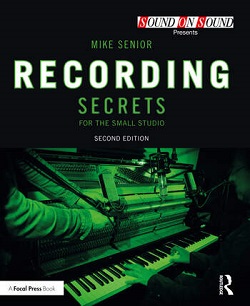Recording Secrets For The Small Studio - Additional Resources
Chapter 10: Adding Spot Arrays
Table of Contents
(This page is for the second edition of Recording Secrets For The Small Studio. To access an archive of the first-edition resource pages, click here.)
Audio Files
(To download all WAV examples at once: 74MB ZIP)
Spot Mics For Balance Correction: The most common reason for using spot mics within a dominant-array setup is to adjust a balance misrepresentation within the dominant array’s signal. For example, in this dominant array recording, the necessity of locating the singer in the organ loft caused her to be underrepresented in the balance Ex09.023: WAV/MP3play_arrow, so a spot mic was recorded Ex09.024: WAV/MP3play_arrow in order to redress this imbalance in the final mix Ex09.025: WAV/MP3play_arrow. As is quite common, a little artificial reverb was used to avoid the spot mic’s more direct sound pulling the vocalist too far forward in the depth perspective.
Spot Mics For Tonal Adjustment: In this dual-pair dominant-array recording the cembalo felt as if it could benefit from a bit more tonal warmth Ex09.026: WAV/MP3play_arrow, simply because the instrument itself sounded rather thin acoustically. A smooth-sounding ribbon spot mic for the cembalo helped here, and using it up close also boosted the instrument’s low end on account of the figure-eight polar pattern’s strong proximity effect Ex09.027: WAV/MP3play_arrow. Mixing this spot-mic signal in with the dominant array lent the instrument’s lower midrange the desired hint of unearnt flattery Ex09.028: WAV/MP3play_arrow. This kind of tonal use of spot mics has many applications, but it’s important to scrutinise the dominant array’s sound before placing the spot, so that you make sure the close mic delivers the necessary tonal character. For example, this drum overheads recording Ex09.029: WAV/MP3play_arrow clearly needs a snare-drum close mic not only to give it more level in the mix, but also to enhance the rather mellow high-frequency content. Sadly, however, the snare close-mic signal on this particular multitrack recording sounded both unnatural and muffled Ex09.030: WAV/MP3play_arrow, and therefore required serious remedial work in Mix Rescue March 2011!
Delaying Spot Mics At The Mix: Here’s a baroque ensemble concert recorded through an ORTF dominant array Ex09.033: WAV/MP3play_arrow. Because the extremely shallow stage required the singer to be well off-axis to the main pair, she was given a separate small-diaphragm condenser spot mic Ex09.034: WAV/MP3play_arrow, and here’s the mix with that faded in Ex09.035: WAV/MP3play_arrow. However, this made the singer feel a little too close to the listener, so the spot mic was delayed 20ms at mixdown (based on measurements of the recording setup taken on the day) to roughly time-align it with the dominant array Ex09.036: WAV/MP3play_arrow. A touch of artificial reverb was also applied to it for similar reasons Ex09.037: WAV/MP3play_arrow.
Equalising Spot Mics At The Mix: Here’s a gospel-choir recorded through a three-mic ‘curtain’ dominant array, supplemented with a direct feed from the accompanying keyboard Ex09.038: WAV/MP3play_arrow. The vocal soloist was also given a close-placed large-diaphragm condenser spot mic Ex09.039: WAV/MP3play_arrow to try to give her more presence in the upper half of the frequency spectrum. However, the mic’s proximity effect also boosted the vocal’s low midrange, making the singer’s tone indistinct and woolly when the spot mic was mixed in with the rest of the ensemble Ex09.040: WAV/MP3play_arrow. Cutting these unwanted lower frequencies with an EQ on the spot mic dealt with this problem Ex09.041: WAV/MP3play_arrow, and a splash of reverb then helped place the singer a little further back in the mix Ex09.042: WAV/MP3play_arrow.
Links
- Microphone Specifications: These two sites will provide technical specifications for pretty much any microphone you’re likely to encounter: Microphone Data and Recording Hacks.
Further Reading
Background Reading & Case Studies Of Dominant-array Recording: The Sound On Sound magazine archives have plenty of good material here. Hugh Robjohns’s ‘Stereo Microphone Techniques Explained’ series is well worth a read (Part 1; Part 2) for a historical perspective on the technical side of things, and there are several articles which discuss case studies of this kind of recording in depth too: Session Notes August 2014; Session Notes January 2016; Session Notes April 2016; Session Notes April 2017; Session Notes August 2017; ‘Recording A String Section: Theory & Practice’; ‘Recording Violin & Piano; ‘Recording A Live Choral Performance’; and ‘Recording A Choir On Location’ (part 1; part 2). I’d also highly recommend tracking down the Delos-label recordings specifically discussed in John Eargle’s The Microphone Book, because they add an extra dimension of usefulness to what is already one of the essential books on the subject.
Using Artificial Reverb: Here’s a fairly entry-level Sound On Sound article to get you off the starting blocks if you’re new to reverb effects: ‘Using Reverb Like A Pro’. There’s more than enough information about it in there for tracking purposes.
Creating Your Own Reverb Impulse Responses: If you’re interested in experimenting with recording your own reverb impulse responses, then here are a couple of videos (Video 1; Video 2) that approach the task in a budget-friendly manner using the built-in convolution plug-in within Cockos Reaper



